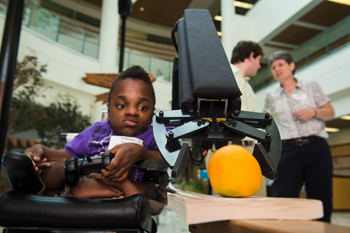Students build device for wheelchair-bound Shriners patient to give him more independence
It was a big day for Dee Faught when a team of Rice University students gave him a helping hand. In fact, they gave him a whole arm.
The bioengineering students won Rice’s George R. Brown School of Engineering Design Showcase and Competition last April for their R-ARM, a robotic device for Faught that fits his motorized chair. A video game controller allows Faught to manipulate the robotic arm. The students had the eager teen try a nearly finished version of the device Sept. 20 at Shriners Hospital for Children in Houston.
Faught, 17, lives with osteogenesis imperfecta, a genetic condition that makes his bones especially brittle. The device will enable him to perform tasks most people take for granted.
“It will help him reach into the cabinets and get a cup or something he can’t get to from his chair by himself,” said his mom, Stacy Faught. “One of the things I’m excited about is that he’ll be able to pick up his laundry off the floor.”

Dee Faught picks up a shirt with a robot arm installed on his motorized wheelchair by Rice bioengineering students including Sergio Gonzalez, standing at left, and Nimish Mittal, right. Photo by Jeff Fitlow
“We’ve seen a lot of people tell him he’s not going to be able to do certain things,” said his dad, Keith. “Dee’s not one to say, ‘I can’t do it.’ He’ll figure out a way.”
Members of Team Brittle Bones — Rice juniors Matthew Nojoomi, Nimish Mittal and Sergio Gonzalez – designed the robotic arm. Faught’s doctor, Gloria Gogola, had suggested to their adviser. Ann Saterbak, that some students consider designing a device to help Faught. Saterbak is a professor in the practice of bioengineering education,
“I expected a high level of engineering talent,” said Gogola, an orthopedic surgeon at Shriners who has advised several design teams at Rice. “But I was astounded at the amount of sensitivity they had toward Dee. It gives me hope that there are young engineers out there who are so sensitive to people with special needs who are fantastic in their own right.”

Dee Faught, who is wheelchair-bound with osteogenesis imperfecta, a genetic disease that makes his bones brittle, will receive a robot arm built by Rice University students to help him be more independent. With him, standing from left, are Nimish Mittal, Matthew Nojoomi, adviser Ann Saterbak and Sergio Gonzalez. Photo by Jeff Fitlow
“It will help me be more independent,” said Faught, who lives with his parents and siblings in Friendswood, Texas. “Now that I’m going to get it, I can’t wait. Not many kids I know get to get a robotic arm.”
The students, who did the bulk of their work at Rice’s Oshman Engineering Design Kitchen, hope to commercialize the product, they see themselves working on it even after graduation. They are applying for grants to further develop R-ARM and hope to work with advisers at Rice’s Jones Graduate School of Business to devise a business plan.
Gonzalez said he is aware of commercial robotic arms that cost upward of $25,000. The students made Faught’s arm for $800. “As we start producing more, the cost could go down even further,” Nojoomi added.
The team members are booked to discuss R-ARM this week at the Biomedical Engineering Society conference in Seattle, after which they’ll return to work on Faught’s robot. They plan to add a few more features they discussed with Dee last week before turning it over to him permanently. Then they’ll check in on a regular basis with the Faughts to see how things are progressing.
“We’ll set up a repair manual for his parents and for students at Rice so that even when we’re gone, they can bring the arm back and fix it up,” Gonzalez said.

Dee Faught picks up an orange during testing of the robot arm built for him by students at Rice University. Photo by Jeff Fitlow
Faught plans to attend Houston Community College for the next two years and then transfer to a school in New York to pursue a career in music. He currently DJs events, but would like to advance into production of his own and others’ music.
“He’s an incredible kid,” Mittal said. “I think that’s part of the reason we stuck with it. If it was just an abstract kind of project, we would have been less motivated. But the fact that we were building it for Dee drove us. We didn’t want to disappoint him.”
Last week, Faught was thrilled to see how far development of the arm has come. Once it was attached to the chair and the modified controller for the arm was in his hands, the team set Dee to work. They laid out objects on a bench to let him test the R-ARM, and after a bit of practice, they dropped items, including a shirt, on the floor as well. He positioned his chair, lowered the arm, pinched the fabric, lifted it to within his own arm’s reach and grabbed it … and gave his mom a knowing smile.

